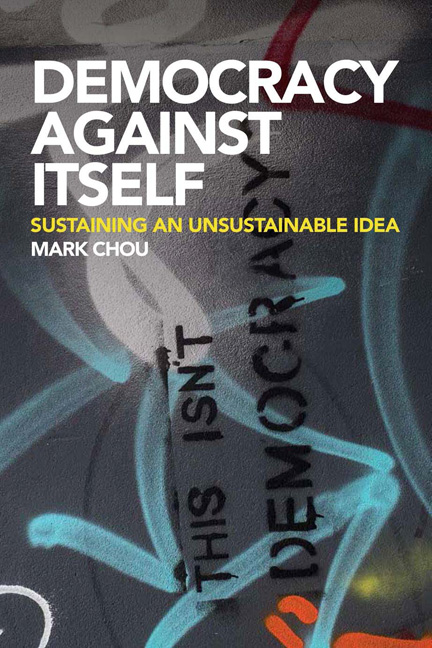Book contents
- Frontmatter
- Contents
- Introduction
- 1 Democracy Against Itself
- 2 Democracy in Athens: Autonomy, Tragedy and Decline
- 3 Democide in Weimar: Militant Democracy and the Paradox of Self-Defence
- 4 The Coming Authoritarianism: The State of America's Democracy
- 5 China's New Authoritarianism: A Glimpse at Our Post- Democratic Future?
- 6 Occupy Democracy: Democracy Against Itself and the Global Occupy Movement
- Bibliography
- Index
6 - Occupy Democracy: Democracy Against Itself and the Global Occupy Movement
Published online by Cambridge University Press: 07 December 2017
- Frontmatter
- Contents
- Introduction
- 1 Democracy Against Itself
- 2 Democracy in Athens: Autonomy, Tragedy and Decline
- 3 Democide in Weimar: Militant Democracy and the Paradox of Self-Defence
- 4 The Coming Authoritarianism: The State of America's Democracy
- 5 China's New Authoritarianism: A Glimpse at Our Post- Democratic Future?
- 6 Occupy Democracy: Democracy Against Itself and the Global Occupy Movement
- Bibliography
- Index
Summary
There was a time, really for much of 2012, when one could go almost nowhere and not hear the ubiquitous rally cry, ‘We are the 99 percent’, made famous by the Occupy Movement. Irrespective of language, culture or geography, Occupy's main premise seemed to strike a chord with people who had never in their lives considered themselves in the same sentence as Wall Street. From those camped out in Manhattan's Zuccotti Park, barely a block away from Wall Street proper, to Occupiers gathered in Kuala Lumpar's Merdeka Square, Sydney's Martin Place and Hong Kong's HSBC Main Building, the movement that began as a protest, a US Day of Rage, quickly burst beyond national borders and became a global phenomenon within a matter of weeks.
As a representative claim, the 99 per cent was immensely powerful. Accurate or not, intentional or otherwise, the use of the 99 per cent explicitly tapped into democracy's arsenal to make plain the democratic discontent at the increasingly unrepresentative nature of most advanced democracies. How could mature democracies in the United States and elsewhere claim to be representative of the majority when popularly elected governments continue to relegate the needs of the 99 per cent so that the desires of the 1 per cent can be met? How can the buying and selling of votes, the inequitable distribution of the country's resources and the widening chasm between rich and poor be consonant with democracy? Far from what has been taking place in the corridors of political power in Washington, London or Canberra in recent years, Occupiers claimed that real democracy is no longer what citizens have become accustomed to. Real democracy is no longer produced through national elections; a vote for the big parties is as good as a vote for the 1 per cent.
And so, even as critics began attacking the movement for its apparent lack of demand, Occupiers were clear that their protest was against democracy as much as it was against anything.
- Type
- Chapter
- Information
- Democracy Against ItselfSustaining an Unsustainable Idea, pp. 139 - 163Publisher: Edinburgh University PressPrint publication year: 2014



